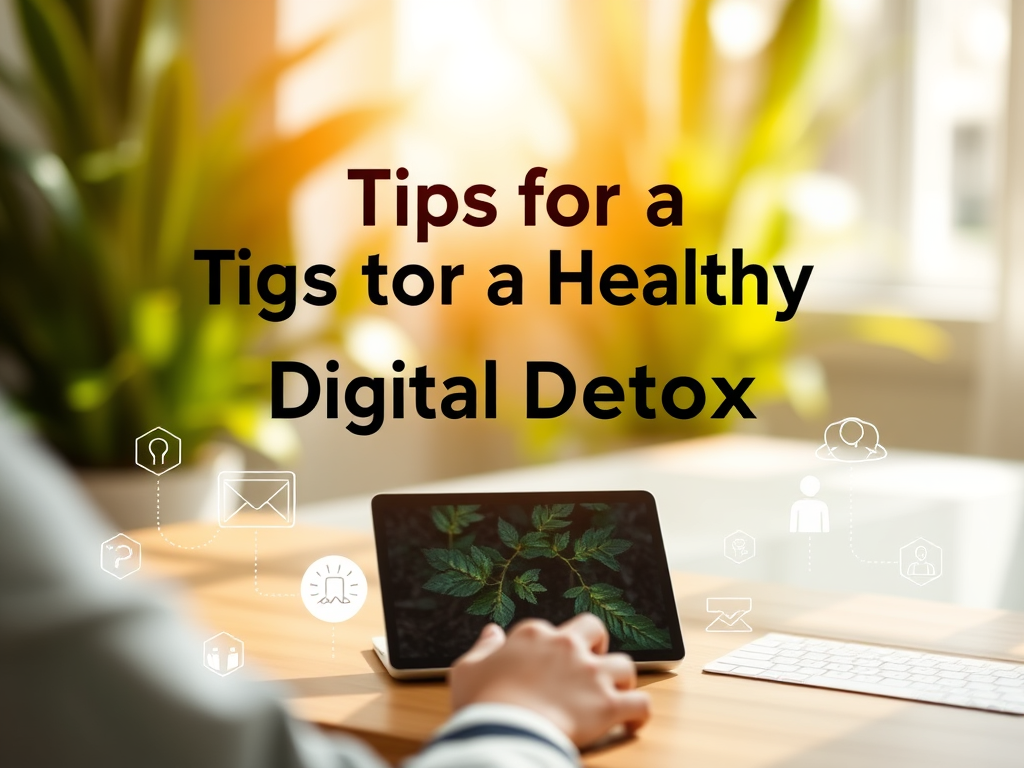Introduction to Digital Detox
In our increasingly interconnected world, the term ‘digital detox’ has emerged as a vital practice aimed at addressing the overwhelming presence of technology in our daily lives. A digital detox refers to a deliberate period during which individuals refrain from using digital devices, particularly smartphones, computers, and social media platforms. This timeout from screens allows for reflection, rejuvenation, and reconnection with oneself and others in a more meaningful way.
The necessity of engaging in a digital detox has grown significantly as research highlights the psychological and physical toll of constant screen exposure. Prolonged digital engagement may lead to symptoms such as eye strain, sleep disturbances, anxiety, and even feelings of isolation. Moreover, the incessant notifications and the pressure to remain constantly available can cultivate a sense of stress and mental exhaustion. Disturbingly, studies suggest that excessive screen time can negatively impact emotional well-being, potentially leading to feelings of inadequacy or diminished self-esteem, particularly in younger users who are frequently active on social media.
Embarking on a digital detox journey can offer substantial benefits for mental health and overall well-being. By temporarily disconnecting from screens, individuals can experience improved concentration, enhanced mood, and greater mindfulness. This period away from technology also opens the opportunity for individuals to reconnect with nature, engage in physical activities, and nurture interpersonal relationships without the interruptions inherent in our digital communications.
As we navigate the challenges posed by our hyper-connected existence, recognizing the importance of regularly disconnecting from screens can serve as a proactive step towards fostering a healthier, more balanced lifestyle. Digital detox is not merely a trend, but rather an essential practice in reclaiming control over one’s time and mental space in an ever-demanding digital environment.

Signs You Need a Digital Detox
As our lives become increasingly intertwined with technology, it is crucial to recognize when our digital habits may be negatively impacting our well-being. Several signs can indicate that a digital detox is necessary for restoring balance and improving quality of life. One of the most common indicators is feeling overwhelmed by notifications. The constant bombardment of alerts from various applications can lead to feelings of stress and anxiety, making it difficult to concentrate on other tasks.
Another prevalent sign that suggests a digital detox may be in order is a noticeable decline in productivity. If individuals find themselves frequently distracted by social media, emails, or other online activities, they may be hindering their ability to complete essential tasks. Assessing how digital devices interfere with daily responsibilities can provide clarity on whether a detox is warranted.
Increased anxiety or stress related to online presence is another significant indicator. Many people experience pressure to remain constantly connected, leading to feelings of inadequacy and self-doubt when offline. This pressure can stem from social comparisons or the fear of missing out, both of which contribute to an unhealthy relationship with technology.
Finally, social isolation is a critical sign that one may benefit from a digital detox. Although technology is often perceived as a facilitator of connection, excessive screen time can result in reduced face-to-face interactions. If individuals find themselves feeling lonely despite virtual connections, it may be time to step back and reassess their digital consumption. Recognizing these signs of excessive screen time is the first step toward reclaiming a more balanced and fulfilling life. By addressing these indicators, individuals can better understand their relationship with technology and its impact on their overall well-being.

Benefits of a Digital Detox
In today’s technology-driven world, the continuous exposure to screens can lead to a cascade of negative effects on our well-being. Engaging in a digital detox can substantially benefit various aspects of life, including mental clarity, sleep quality, real-life relationships, and productivity levels. One of the most immediate advantages is the enhancement of mental clarity. Numerous studies indicate that reducing screen time can prevent cognitive overload, allowing the mind to rest and rejuvenate. For instance, research published in the Journal of Environmental Psychology demonstrated that participants who took breaks from their devices exhibited significant improvements in attention span and problem-solving skills.
Another critical benefit of a digital detox is better sleep quality. The blue light emitted from screens is known to interfere with melatonin production, disrupting natural sleep patterns. A study conducted by the Sleep Research Society found that individuals who limited screen exposure before bedtime reported deeper, more restful sleep compared to those who did not. Enhanced real-life relationships are also a notable byproduct of minimizing screen time. Engaging face-to-face with friends and family fosters stronger emotional bonds, as illustrated by research from the American Psychological Association, which links in-person interactions with increased feelings of connectedness and reduced feelings of loneliness.
Moreover, a digital detox can lead to heightened productivity levels. The constant distractions from notifications and social media can fragment attention and reduce focus. A survey conducted by Harvard Business Review found that employees who adhered to a digital detox reported improved concentration, allowing them to complete tasks more efficiently and effectively. By re-claiming time from screens, individuals can invest it in creative pursuits or skill development, further enhancing their personal and professional growth.
Overall, the benefits of a digital detox are multi-faceted, making it a worthwhile consideration for anyone seeking to improve their quality of life.

Planning Your Digital Detox
Embarking on a digital detox journey requires careful planning and consideration to ensure a successful outcome. The first step is to set realistic goals that align with your lifestyle and the outcomes you wish to achieve. For instance, you might aim to reduce your daily screen time by a specific number of hours or commit to device-free periods during meals and before sleep. Setting achievable milestones is crucial to maintain motivation throughout the detox.
Identifying triggers for screen usage is another vital component of a digital detox. Reflecting on when and why you reach for your devices can help you develop strategies to mitigate these impulses. Common triggers may include boredom, anxiety, or the habit of scrolling during downtime. By recognizing these moments, you can create alternative activities to engage in, such as reading, exercising, or pursuing hobbies that do not involve screens.
Determining the length of your detox period is equally important. You may choose to embark on a short-term detox of a weekend or extend it to several weeks depending on your needs and commitment levels. A gradual reduction in screen time is often more sustainable; this could involve designating specific times for device use and increasing these intervals over time. Gradually scaling back allows your mind and body to adjust without the shock of an abrupt disconnection.
Establishing boundaries surrounding technology use is essential to a successful detox. This may include creating phone-free zones in your home, or setting specific hours during which devices are turned off. Communication with family and friends about your detox intentions can also promote accountability, encouraging those around you to support your efforts. By implementing these strategies, you can reclaim control over your screen time, enhancing your overall well-being.

Tips for a Successful Digital Detox
In today’s fast-paced, technology-driven society, the challenge of undertaking a digital detox is ever-present. To successfully reclaim your life from screens, adherence to actionable strategies is essential. One effective approach is to engage in alternative activities that promote relaxation and social interaction. Consider exploring hobbies that do not involve screens, such as reading physical books, painting, or engaging in outdoor activities like hiking or gardening. These provide wholesome substitutes, allowing you to disconnect while fostering personal growth and creativity.
Mindfulness practices can significantly enhance your digital detox journey. Incorporating activities such as yoga or meditation can help recalibrate your focus away from screens and towards your inner self. Allocate specific times each day for mindfulness exercises; this not only reduces stress but also encourages a genuine connection with the present moment. Techniques like deep breathing or setting intentions can enhance clarity and emotional well-being, making it easier to avoid the temptation of digital devices.
Creating tech-free zones within your home can also be beneficial. Designate certain areas, such as the bedroom or dining room, as spaces where screens are not allowed. This encourages quality time with family or friends, promoting interpersonal relationships while reducing reliance on technology. Furthermore, involving a support system can be a crucial motivator. Share your goals with friends or family members, and encourage them to participate in the detox process. Having accountability partners can provide a sense of camaraderie and encouragement, fostering a supportive environment as you navigate the challenges of reducing screen time.
Overall, implementing these strategies will advance your commitment to a digital detox and improve your overall quality of life. By finding alternatives, practicing mindfulness, and establishing support systems, you can successfully disconnect and foster a healthier balance with technology.

Activities to Replace Screen Time
In the era of digital dominance, it is easy to become engulfed in screen time, often at the expense of engaging in fulfilling offline activities. A digital detox offers an invaluable opportunity to explore various hobbies and activities that can enrich your life while reducing reliance on screens. One of the most rewarding alternatives to screen time is reading. Immersing oneself in a captivating novel or exploring new realms through non-fiction can ignite imagination and stimulate mental engagement. Books transport readers to different worlds, allowing for a refreshing escape from the digital landscape.
Another enriching activity is cooking. Experimenting with new recipes or honing culinary skills can be both exciting and therapeutic. Preparing meals from scratch encourages creativity and allows individuals to savor the fruits of their labor. Moreover, cooking can be a communal activity, providing a wonderful opportunity for bonding with family or friends while reinforcing essential life skills.
Physical exercise serves as an excellent substitute for screen time, offering a dual benefit of enhancing physical health and improving mental well-being. Whether it is a brisk walk in the park, joining a local sports team, or practicing yoga, physical activities can invigorate both the body and mind. Engaging in outdoor workouts can also foster a connection with nature, amplifying the detox experience.
Lastly, connecting with nature through activities such as hiking, gardening, or simply enjoying a quiet moment outdoors can be incredibly restorative. Spending time in natural surroundings not only aids in reducing stress levels but also enhances overall mood. The myriad of offline activities available highlights the importance of stepping away from screens to rediscover joy in life’s simpler pleasures. Engaging in these hobbies facilitates a deeper connection to oneself and the world surrounding us, ultimately promoting a healthier lifestyle.

Challenges of Digital Detoxing
Embarking on a digital detox can be a daunting endeavor, as individuals may encounter a variety of challenges that hinder their efforts. One of the most common hurdles faced is the emotional and psychological withdrawal from digital devices. With constant connectivity and engagement through screens, many individuals develop a reliance on their devices for social interaction, information, and entertainment. When suddenly confronted with the absence of these digital conveniences, feelings of irritability and anxiety may arise, making the initial transition more difficult.
Another significant challenge lies in the pervasive phenomenon known as FOMO or the Fear of Missing Out. This anxiety often stems from a concern about missing important updates, social gatherings, or trending topics prevalent on social media platforms. The pervasive nature of online sharing can amplify this sense of urgency, leading individuals to feel compelled to remain digitally vigilant, thus contradicting the essence of a digital detox. It is essential to acknowledge this fear and recognize that taking a break may enhance one’s well-being rather than detract from it.
Additionally, habitual behaviors form a substantial barrier during a digital detox. Many individuals have ingrained routines that involve regular interactions with their devices, whether checking emails, scrolling through social media, or fervently consuming online content. Breaking these habits requires conscious effort and commitment. It is advisable to proactively establish a structured plan that outlines specific offline activities such as reading, exercising, or engaging in face-to-face conversations. Such alternatives can effectively redirect attention away from screens, allowing individuals to reconnect with their surroundings and themselves.
By understanding and addressing these challenges—withdrawal symptoms, FOMO, and habitual behavior—individuals can better equip themselves for a successful digital detox journey. Acknowledging these obstacles fosters resilience and reinforces the ultimate goal of reclaiming time and mental space away from screens.
Post-Detox: Integrating Healthy Tech Habits
Completing a digital detox marks a significant step towards reclaiming control over your life from screens, but the journey does not end there. In order to maintain the benefits of a digital detox, it is crucial to mindfully reintroduce technology into your daily habits. This phase requires a strategic approach that focuses on setting healthy boundaries and consciously selecting digital tools that foster well-being rather than detracting from it.
One effective strategy is to establish designated screen times. By committing to specific intervals when you will use your devices, you can create a more balanced relationship with technology. For instance, you might choose to check emails or social media for a set period each morning and evening, reserving the rest of your time for activities that do not involve screens. This allows you to enjoy the benefits of connectivity without allowing it to dominate your day.
Additionally, consider evaluating the digital tools you incorporate into your routine. Not every app or platform contributes positively to your life. Take the time to identify those that enhance your well-being, whether they are productivity apps, educational platforms, or mindfulness tools. Conversely, be wary of engagements that lead to distraction or unnecessary stress. Implement a routine check on your applications to ensure they align with your goals and values.
Furthermore, setting boundaries with notifications and alerts can significantly reduce the temptation to check your devices unnecessarily. Disable non-essential notifications, allowing only those that truly enhance your productivity or well-being. Also, create tech-free zones or times, such as during meals or before bedtime, to encourage a healthier balance between your online presence and real-world interactions.
By adopting these strategies and remaining intentional about your technology use, you can create a sustainable lifestyle that supports both productivity and well-being, ultimately allowing you to thrive post-detox.

Final Thoughts on Digital Detoxing
In today’s fast-paced digital landscape, the importance of maintaining balance in technology use cannot be overstated. As individuals become increasingly dependent on devices for communication, entertainment, and information, it is vital to reassess these habits regularly. The act of digital detoxing, which involves taking a deliberate break from screens and online interactions, serves as a necessary intervention in mitigating the adverse effects of continuous connectivity. This practice not only aids in reducing stress and improving focus but also fosters meaningful connections with others and with oneself.
Conducting periodic digital detoxes encourages individuals to recalibrate their relationship with technology. Whether it involves a day of complete disconnection or scheduled intervals of screen-free time, these breaks can lead to significant enhancements in mental clarity, emotional wellbeing, and productivity. Additionally, establishing boundaries around technology use, such as designated screen-free hours during meals or before bedtime, collectively contributes to a healthier lifestyle. Such practices help individuals engage more fully with the present moment and cultivate deeper relationships with those around them.
Ultimately, it is crucial to remember that technology should serve as a tool to enrich our lives rather than dictate how we live them. By embracing the concept of digital detoxing, individuals can protect their mental health and foster a more sustainable, fulfilling existence. Encouragement towards this endeavor should not only stem from recognizing the need for change but also from the potential benefits that arise from it. In this age of constant connectivity, taking time to disconnect and reassess one’s digital habits offers an invaluable opportunity to reconnect with the essential aspects of life. Embrace the journey of digital detoxing to reclaim your personal space and establish a healthier balance with technology.
